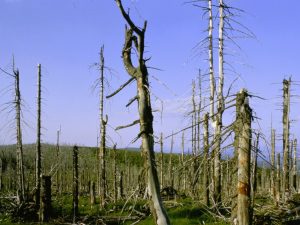Acid rain sounds like a made -up idea from a sci-fi movie; when acid rain comes, people run for cover to keep the rain from melting their skin. The truth is, acid rain is real and is affecting our environment every day!
-up idea from a sci-fi movie; when acid rain comes, people run for cover to keep the rain from melting their skin. The truth is, acid rain is real and is affecting our environment every day!
Acid rain is not an alien made torture device, it comes from human made toxins. When excess sulfur dioxide and nitrogen oxides are released into the atmosphere, the compounds react with water releasing hydrogen ions that decrease the pH of the rain. The normal pH of rain is around 5.6, but acid rain has a pH of approximately 4.3! To give a comparison, tomato juice and black coffee have about the same level of acidity. Acid rain dramatically affects ecosystems, especially aquatic environments. Many sea creatures cannot survive in acidic environments. It not only kills the animals sensitive to the acid, but it also disrupts the food chain by eliminating food sources for other animals. Acid rain can also damage plants by removing essential nutrients from the soil, such as magnesium. The picture above shows the detrimental effect of acid rain on a forest in Poland. It destroyed all the foliage, as well as the habitat for all the creatures that used to live there.
How can we stop acid rain from destroying our planet? Well, excess sulfur and nitrogen oxides mainly come from burning fossil fuels by means of factories, vehicles, and power plants. On a global level, we can stop it by shifting towards using more renewable sources of energy such as solar and wind power. But more importantly, individuals can make daily changes to stop using excessive amounts of energy that comes from burning fossil fuels. One way to do this is to use alternative forms of transport to gasoline cars. You can buy an electric car, carpool, or bike! You can also try to use less energy by turning off heating and cooling systems when they aren’t necessary or by turning off electronic devices and lights when they are not being used. Individually making small changes does not seem like it will make a difference, but if everyone makes an effort, we can collectively make a tremendous change.
Olivia Larner
Sources:
https://www.epa.gov/acidrain/effects-acid-rain
http://www.nationalgeographic.com/environment/global-warming/acid-rain/